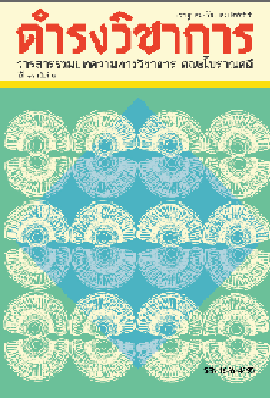AN ASSUMPTION ON WORDS “ตัว” [TUA] AND “ตน” [TON]
Keywords:
“ตัว” (คำ), “ตน” (คำ), ข้อสันนิษฐาน, นิรุกติศาสตร์Abstract
The meanings of words “ตัว” [tua] and “ตน” [ton] resemble very much. The Royal Institute Dictionary B.E. 2493 identifies sources of the both as Thai Words. It is interested to seek that are both the original Thai words? As presumed, there may be the word [tua] used in Thai language before and the word [ton] may has afterwards been received from the word “ตนุ”[tanu] derived from Pali-Sanskrit. The writer collected data from Dictionaries in different periods including documents in Sukhothai period namely; inscriptions, Trai Phum Phra Ruang, Tai Dialects and other languages and finally the word [tua] and [ton] used since Sukhothai period have been found explicitly. The word [ton] have been used in Sukhothai period and it has obviously been found in many evidences due to the contents in inscriptions, excepting King Ramkhamhaeng’s inscription No.1 and Trai Phum Phra Ruang, dealt mainly with the religious essences. As studied other Dialects, the word [tua] has implicitly been found, but the word [ton] have not been found at all. Furthermore, the additional evidences are derived from Khmer that there is the word “ขฺลวน” [khluan] meaning body as well as the word [tanu] to use. Such the words are regarded as the evidences in order to support the word [ton] came from [tanu] and then there are sound changes in Thai language, which corresponded to the presumption as given by Khun Wijitramatra (Sa-Nga Kanchanapan) (2511:121-123) that the word [ton] derived from Pali-Sanskrit is recognized as the word “ดนู”[Danu].
References
ศึกษาธิการ, กรม. หนังสือพจนานุกรม. พิมพ์ครั้งที่ ๒. พระนคร: โรงพิมพ์พิศาลบรรณนิติ์, ๒๔๔๔
บรัดเลย์, บี. หนังสืออักขราภิธานศรับท์ (Dictionary of the Siamese Language). พระนคร : ม.ป.ท., ค.ศ. ๑๘๗๓, ๒๔๑๖
บวรบรรณรักษ์, หลวง. สํสกฤต-ไท-อังกฤษ อภิธาน. พิมพ์ครั้งที่ ๔. กรุงเทพฯ: โสภณการพิมพ์, ๒๕๕๒
ป.หลง สมบุญ (นามแฝง). พจนานุกรมบาลี-ไทย. กรุงเทพฯ: โรงพิมพ์คุรุสภา, ๒๕๑๙
ประเสริฐ ณ นคร. อักษร ภาษา จารึก วรรณกรรม รวมบทนิพนธ์เสาหลักทางวิชาการของศาสตราจารย์ ดร.ประเสริฐ ณ นคร. กรุงเทพฯ :สํานักพิมพ์มติชน, ๒๕๔๙
______. การอธิบายศิลาจารึกสมัยสุโขทัย. นนทบุรี : มหาวิทยาลัยสุโขทัยธรรมาธิราช, ๒๕๔๗
พจนานุกรมเขมร-ไทย ฉบับทุนพระยาอนุมานราชธน เล่ม ๑. พระนคร :จงเจริญการพิมพ์, ๒๕๑๗
พจนานุกรมบาลี-ไทย-อังกฤษ ฉบับภูมิพโลภิกษุ. พระนคร : มูลนิธิภูมิพโลภิกษุ, ๒๕๓๑
มหาวิทยาลัยมหาจุฬาลงกรณราชวิทยาลัย. พระไตรปิฎก. (ซีดี-รอม). ซีดี-รอมฉบับเรียนพระไตรปิฎก. กรุงเทพฯ : มหาวิทยาลัยมหาจุฬาลงกรณราชวิทยาลัย, ๒๕๔๕
ลิไทย, พระยา. ไตรภูมิพระร่วง. พิมพ์ครั้งที่ ๘. ธนบุรี: โรงพิมพ์รุ่งวัฒนา, ๒๕๑๓
ราชบัณฑิตยสถาน. ม.ป.ป. พจนานุกรมฉบับราชบัณฑิตยสถาน พ.ศ. (๒๔๙๓). ม.ป.ท.
________. พจนานุกรมฉบับราชบัณฑิตยสถาน พ.ศ. ๒๕๒๕. กรุงเทพฯ: อักษรเจริญทัศน์, ๒๕๒๕
________. พจนานุกรมฉบับราชบัณฑิตยสถาน พ.ศ. ๒๕๔๒. กรุงเทพฯ: นานมีบุ๊คส์พับลิเคชั่นส์, ๒๕๔๖
วิจิตรมาตรา, ขุน. ลักษณะและวิวัฒนาการของภาษาไทย. พระนคร: สํานักพิมพ์สาส์นสวรรค์, ๒๕๑๑
วิไลวรรณ ขนิษฐานันท์. ภาษาแสก. กรุงเทพฯ: โรงพิมพ์มหาวิทยาลัยธรรมศาสตร์, ๒๕๑๙
________. ภาษาผู้ไทย. กรุงเทพฯ : โรงพิมพ์มหาวิทยาลัยธรรมศาสตร์, ๒๕๒๐
ศิลปากร, กรม. จารึกสมัยสุโขทัย. กรุงเทพฯ : กองวรรณคดีและประวัติ-ศาสตร์, ๒๕๒๖
Apte, Vaman Shivram. The Practical Sanskrit-Dictionary. 11th reprint. Delhi: Motilal Banarsidass, 2010
Ishii Yoneo, Akagi Osamu and Endo Noriko. A Glossarial Index of The Sukhothai Inscriptions : SEAS Discussion Paper No.53. Kyoto: Kyoto University, 1972
Monier-Williams, Sir M. Sanskrit-English Dictionary. Delhi : Motilal Banarsidass, 1970
Downloads
Issue
Section
License
บทความนี้เป็นผลงานของข้าพเจ้าแต่เพียงผู้เดียว และ/หรือเป็นผลงานของข้าพเจ้าและผู้ร่วมงาน ตามชื่อที่ระบุในบทความจริง และเป็นผลงานที่มิได้ถูกนำเสนอหรือตีพิมพ์ที่ใดมาก่อน





